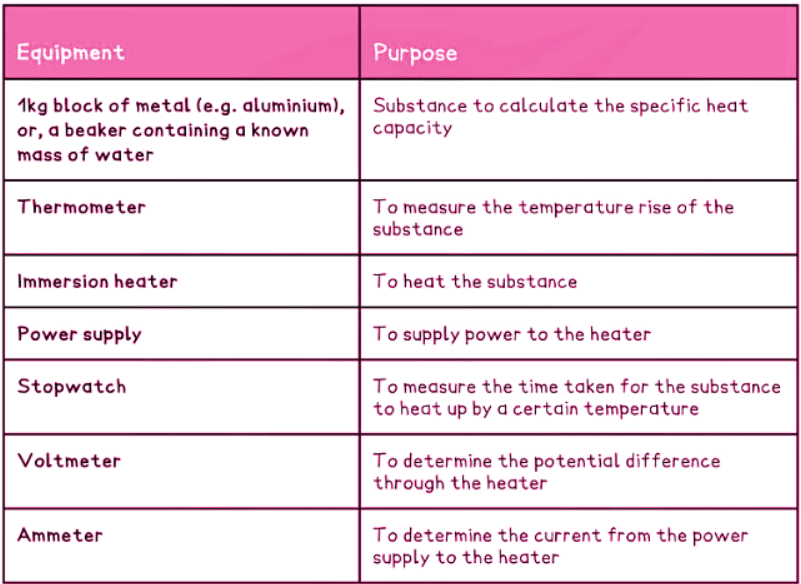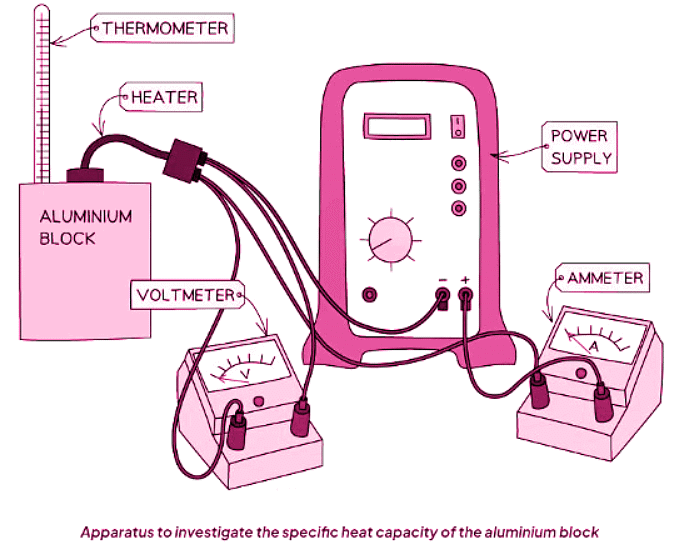Class 10 Exam > Class 10 Notes > Physics for GCSE/IGCSE > Investigating Specific Heat Capaci
Investigating Specific Heat Capaci | Physics for GCSE/IGCSE - Class 10 PDF Download
Investigating Specific Heat Capacity (Extended)
Aims of the Experiment
- The experiment seeks to establish the specific heat capacity of a substance by connecting the reduction in one form of energy (or work performed) to the rise in temperature and consequent elevation in stored thermal energy.
Variables
- Independent variable = Time, t
- Dependent variable = Temperature, θ
- Control variables:
- Material of the block
- Current supplied, I
- Potential difference supplied, V
Equipment List

- Resolution of measuring equipment:
- Thermometer = 1 °C
- Stopwatch = 0.01 s
- Voltmeter = 0.1 V
- Ammeter = 0.01 A
Method

- Start by assembling the apparatus, placing the heater into the top of the block
- Measure the initial temperature of the aluminium block from the thermometer
- Turn on the power supply and start the stopwatch
- Whilst the power supply is on, the heater will heat up the block. Take several periodic measurements, e.g., every 1 minute of the voltage and current from the voltmeter and ammeter respectively, calculating an average for each at the end of the experiment up to 10 minutes
- Switch off the power supply, stop the stopwatch, and leave the apparatus for about a minute. The temperature will still rise before it cools
- Monitor the thermometer and record the final temperature reached for the block
Analysis of Results
- The thermal energy supplied to a block can be determined using the formula:
E = IVt - Where:
- E represents thermal energy (in joules),
- I is current (in amperes),
- V denotes potential difference (in volts), and
- t stands for time (in seconds).
- The change in thermal energy can be calculated through the equation:
ΔE = mcΔθ - Where:
- ΔE signifies the change in thermal energy (in joules),
- m refers to mass (in kilograms),
- c represents specific heat capacity (in joules per kilogram per degree Celsius), and
- Δθ indicates the change in temperature (in degrees Celsius).
- Rearranging for the specific heat capacity, c:

- To calculate Δθ:
Δθ = final temperature – initial temperature - To calculate ΔE:
- ΔE = IVtf – IVti
- Where:
- I = average current, in amperes (A)
- V = average potential difference (V)
- tf = final time, in seconds (s)
- ti = initial time, in seconds (s)
- These values are then substituted into the specific heat capacity equation to calculate the specific heat capacity of the aluminium block
Evaluating the Experiment
Systematic Errors- Ensure that both the voltmeter and ammeter are calibrated to zero initially to prevent zero error.
Random Errors
- Not all the heat energy supplied to the block is entirely transferred; some is dissipated into the surroundings or may heat up the thermometer. Consequently, the measured specific heat capacity might appear higher than the actual value. To mitigate this, it is crucial to insulate the block effectively.
- For improved accuracy, consider using a joulemeter to directly calculate energy. This method helps eliminate errors associated with the voltmeter, ammeter, and stopwatch.
- Ensure that temperature readings are taken at eye level from the thermometer to prevent parallax error.
- Conducting the experiment with a beaker of water of equal mass can offer valuable insights. Water should heat up at a slower rate compared to the aluminum block, aiding in comparative analysis.
Safety Considerations
- Avoid touching the heater while it's operating to prevent burns or fire hazards.
- If burned, promptly rinse the affected area under cold running water for a minimum of 5 minutes.
- Ensure all equipment, including the heater, wire, and block, is allowed sufficient time to cool before storing it.
- Keep water away from any electrical devices.
- When handling a beaker of hot water, wear eye protection as a precaution.
The document Investigating Specific Heat Capaci | Physics for GCSE/IGCSE - Class 10 is a part of the Class 10 Course Physics for GCSE/IGCSE.
All you need of Class 10 at this link: Class 10
|
126 videos|182 docs|35 tests
|
Related Searches















